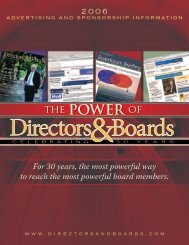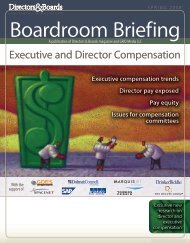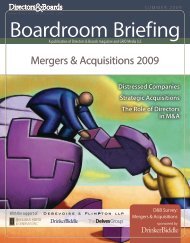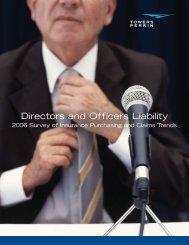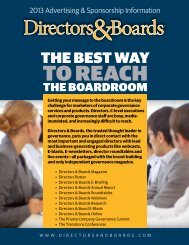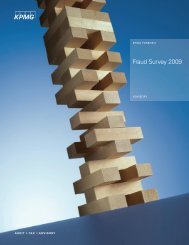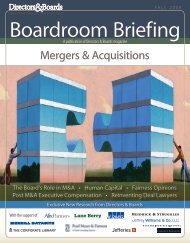The LRN ethics and compliance risk management practices report
The LRN ethics and compliance risk management practices report
The LRN ethics and compliance risk management practices report
Create successful ePaper yourself
Turn your PDF publications into a flip-book with our unique Google optimized e-Paper software.
Educating a<br />
Diverse Workforce<br />
An Interview with Marsha Ershaghi,<br />
Director of Education Solutions, <strong>LRN</strong><br />
A new reality in today’s world is that the workforce<br />
is changing. Companies are increasingly hiring the<br />
“Millennial” generation, those born between 1985 <strong>and</strong><br />
2001, the first wave of whom are now in the early 20s<br />
<strong>and</strong> starting to enter the workforce following completion<br />
from their college or graduate business programs.<br />
Meanwhile, the main body of the workforce continues<br />
to be comprised of baby boomers, those born between<br />
1946 <strong>and</strong> 1964, the first wave of whom will be officially<br />
retiring within the next 3 to 5 years. As one generation<br />
enters while the other exits, companies will increasingly<br />
face a “blended workforce” composed of two groups of<br />
people who literally have different upbringings, values,<br />
social <strong>and</strong> political views, <strong>and</strong> styles of learning.<br />
According to Marsha Ershaghi, Director of Education<br />
Solutions at <strong>LRN</strong> <strong>and</strong> a Doctoral c<strong>and</strong>idate in educational<br />
technology, generational differences in learning will<br />
become a driving force to change how companies<br />
engage employees about <strong>ethics</strong> <strong>and</strong> <strong>compliance</strong>. As<br />
the 2008 survey results demonstrate, relevancy <strong>and</strong><br />
engagement are already key challenges in educating<br />
employees <strong>and</strong> motivating them to take <strong>ethics</strong> <strong>and</strong><br />
<strong>compliance</strong> seriously, as well as to <strong>report</strong> violations.<br />
One cause of this is the fact that many companies have<br />
only recently adopted online educational courses that<br />
offer more flexibility <strong>and</strong> interactive engagement to<br />
employees, as few adults, whether boomer or Millennial,<br />
tolerate dull, lifeless learning.<br />
However, with the Millennials – a generation that grew<br />
up with constant access to computer technology, video,<br />
gaming, <strong>and</strong> the Internet – the methods <strong>and</strong> nature of<br />
engaging them will need to change to accommodate<br />
their preferred learning styles <strong>and</strong> capabilities. “<strong>The</strong>re are<br />
specific ingredients of an effective learning experience<br />
for Millennials,” notes Marsha. “<strong>The</strong>y must have a<br />
blend of analysis <strong>and</strong> critical thinking, with elements<br />
of entertainment, immediate feedback, practical<br />
application, <strong>and</strong> personnel relevance.”<br />
One type of learning that especially appeals to<br />
Millennials is interactive gaming. This is why 10% of<br />
survey respondents in this year’s survey indicate that<br />
some forward-looking companies are already recognizing<br />
its value to educate its younger workforce about <strong>ethics</strong><br />
DISCUSSION<br />
findings – can contribute to a greater underst<strong>and</strong>ing among managers <strong>and</strong> employees,<br />
this more holistic <strong>and</strong> transparent approach takes a step in crossing the threshold towards<br />
making <strong>risk</strong> assessments a key part of the organization’s culture, rather than a <strong>compliance</strong><br />
necessity. In other words, the more everyone in the organization underst<strong>and</strong>s the need to<br />
guard the organization’s reputation <strong>and</strong> assets, the more <strong>risk</strong> assessments will inspire people<br />
to take responsibility for their own culture. It is one element in the process of transitioning<br />
toward self-governance.<br />
Prevent<br />
To be successful, <strong>risk</strong> prevention efforts require that employees recognize the relevance of<br />
the education to their jobs <strong>and</strong> their future <strong>and</strong> buy into the company’s commitment to build<br />
its cultural values. Without that, no amount of education will motivate employees to learn<br />
the rules or be inspired to internalize the company’s values <strong>and</strong> policies. It may be possible to<br />
“train” employees about <strong>compliance</strong> regulations, but “educating” them to assimilate their<br />
significance in the company’s culture <strong>and</strong> to apply them in their everyday conduct cannot<br />
happen without relevancy <strong>and</strong> engagement.<br />
<strong>The</strong> first step in formulating an effective education program must come from the highest<br />
levels, the Board <strong>and</strong> senior leadership, which need to inspire employees by communicating<br />
a clear vision of the company, its culture, <strong>and</strong> its future. Employees must hear <strong>and</strong> believe<br />
that the greater success of the company leads to their greater success. This reality makes<br />
developing senior <strong>management</strong> <strong>and</strong> business <strong>management</strong> education foundational aspects<br />
of a solid prevention program.<br />
Beyond that, companies must offer a wide range of prevention education to suit the<br />
learning styles <strong>and</strong> working habits of their workforce. Programs need to be tailored to the<br />
time <strong>and</strong> schedules that employees have available. <strong>The</strong>y must reflect local cultural <strong>and</strong> legal<br />
underst<strong>and</strong>ings so as to avoid being irrelevant or biased. <strong>The</strong>y need to appeal to the diverse<br />
workforce the company employs, which may include global localization <strong>and</strong> translations.<br />
<strong>The</strong>y are most effective if they are targeted at the employee’s job function <strong>and</strong> how it<br />
intersects with <strong>ethics</strong> <strong>and</strong> <strong>compliance</strong> concerns <strong>and</strong> <strong>risk</strong>s. And, most importantly, they must<br />
engage the employee’s mind <strong>and</strong> heart in order to motivate learning the concepts, adopting<br />
the values, <strong>and</strong> developing confidence <strong>and</strong> trust that the company truly cares to have<br />
employee as part of its culture.<br />
An important element of prevention is that the education should be customized, to the<br />
greatest extent possible, to speak to the employee in a way that engages <strong>and</strong> inspires that<br />
individual. This requires recognizing that the company’s workforce consists of many types of<br />
workers, who will increasingly reflect generational differences in learning style, educational<br />
background, <strong>and</strong> capabilities using technology.<br />
To date, only modest strides are being made in the use of cultural relevant education best<br />
<strong>practices</strong>. While 8 out of 10 companies have codes of conduct, utilize online education,<br />
or offer classroom experiences, 5 in 10 companies struggle with cultural differences, 4 in<br />
10 companies say there are challenges to make the education relevant, <strong>and</strong> 2 in 10 cite<br />
lack of translated materials, low leadership support, or low employee motivation. <strong>The</strong>re is<br />
disconnect between the efforts to educate employees <strong>and</strong> the sense that the efforts are<br />
successful. However, it does appear that companies have recognized the importance of<br />
educating their boards <strong>and</strong> senior leadership <strong>and</strong> have increased efforts since 2007. This<br />
alone is a positive step, but the dots must be also connected between developing the<br />
company’s leadership <strong>and</strong> educating its employees. <strong>The</strong> company must be viewed as one<br />
organization on the same journey.<br />
<strong>LRN</strong> | 2008 Ethics <strong>and</strong> Compliance Risk Management Practices Report | 19



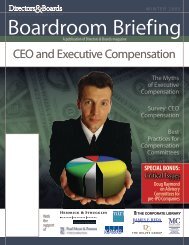
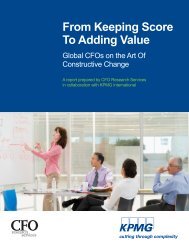
![[link to PDF] for a copy of the briefing paper - Directors & Boards](https://img.yumpu.com/43729022/1/190x245/link-to-pdf-for-a-copy-of-the-briefing-paper-directors-boards.jpg?quality=85)
